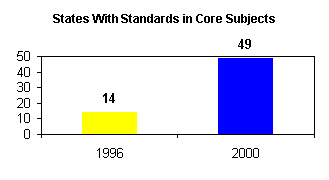
Brief on Educational Progress 1992-2000
PREFACE
Since taking office, President Clinton and Vice President Gore have made better education a cornerstone of their Administration’s priorities, and have focused on ensuring that Americans have the educational opportunities necessary to succeed in today’s global Information Age economy.
Almost eight years after they were elected, the progress on many key education measures stands as testimony to their vision and their efforts on behalf of America’s children to invest more in our nation’s schools and demand more from them. Through their leadership, President Clinton and Vice President Gore have helped raise expectations for all students, supported states in developing and putting in place rigorous standards and systems of assessment and accountability aligned with those standards, and invested in proven strategies to increase the educational performance of all students. As a result, student performance as measured by test scores, rigorous coursework, high school graduation rates, and college enrollment has improved, especially for students in our most disadvantaged schools.
However, relying on this positive momentum is not enough, and President Clinton and Vice President Gore believe that much remains to be done in building upon these important gains. In fact, voters indicate that they see education as the highest priority for additional federal funding – above and beyond other critical national needs such as health care, Social Security, and Medicare – and above tax cuts as well. This agreement on the urgency of federal support to improve our nation’s schools with federal support cuts across the party affiliation of voters. With the juxtaposition of our current economic strength against the awareness of an increasingly international economy, serious federal investment to improve the state of our schools is something that should move out of the realm of partisan debates to the arena of bipartisan action as Congress prepares its Fiscal Year 2001 budget.
Collectively our nation’s leaders must think ahead to capitalize on the gains that have been made by expanding successful education improvement strategies and to make federal investments that have the greatest impact on our future workforce – today’s students.Targeted commitments are especially crucial because the tax cut strategy passed by the Congress this year—in combination with the substantial tax cuts supported by the Congressional majority for next year—would drain over $2 trillion of the projected surplus, effectively ignoring the great opportunity before us to meaningfully invest in the future, and seriously threatening key national priorities—including education.
This brief examines the educational progress over the past eight years in key areas such as standards and accountability, student performance, closing the achievement gap, technology, and increased access to higher education, in the context of key initiatives that have helped the nation’s schools and students make these gains. Throughout this document progress is illustrated by gains in student performance measures such as test scores and access to programs or curricula; in most cases the period examined is 1992 to 1999, though in instances where data was not available for those particular years, data from the closest years is considered and noted as such. Below are a few highlights of this progress:
With the leadership of President Clinton and Vice President Gore, legislative action including Goals 2000, the Reading Excellence Act, and the Improving America’s Schools Act of 1994, helped end the crippling era of watered-down curricula and low expectations for disadvantaged students, and laid a foundation of educational standards and accountability to ensure that all students achieve their full potential. Their leadership on education policy has also meant the reduction of federal paperwork burden and regulation, as well as greater flexibility for states in exchange for but not instead of strong accountability safeguards to ensure true achievement gains by students through the Education Flexibility Partnership Act. Equally important have been significant funding increases which have doubled the federal investment in education and training.
The Administration’s FY 2001 budget priorities such as the 21st Century Community Learning Centers, Teacher Recruitment and Training, Class Size Reduction, School Construction and Modernization, the Title I Accountability Fund, and the Technology Literacy Challenge Fund have played key roles in accelerating achievement gains for our elementary and secondary students. Substantially increased maximum Pell Grants, greater Work-Study opportunities, new tax credits and the GEAR UP mentoring and college preparation program are making the dream of higher education a reality for more Americans. In some cases, Clinton-Gore initiatives have been based upon efforts that were reaping demonstrable success at the state and local levels, and in others, policies have drawn on the findings of an extensive research base – in other words, the educational budget priorities of this Administration have been rooted in what we know works to improve student learning.
However, research has again proven what common sense tells us – investment matters, but significant investment must be balanced with accountability for results. It is critical to remember that while the federal investment in education is the largest today that it has been in 30 years, it is not just the overall dollar amount, but rather the way in which funds have been targeted that has generated positive results during the Clinton-Gore Administration. It is these innovative areas that we need to be looking to as we continue to shape both the leadership and supportive roles that the federal government can play in our nation’s schools. The President and Vice President are committed to demanding more from our schools and investing more in them to continue the progress of the past seven-and-a-half years and to move closer to the goal of a high quality education for every single child in the nation.
National Leadership on Standards and Accountability

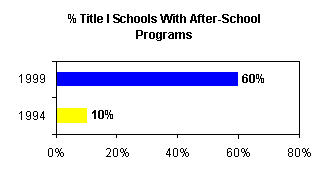
In 1994, with the passage of the Goals 2000: Educate America
Act and the Improving America’s Schools Act, President Clinton and Vice
President Gore led the nation in charting a new course for American public
education. With this legislation, the Administration raised expectations for
all students to achieve to high standards and rallied bipartisan support and
funding for State efforts to establish challenging academic standards,
high-quality assessments to measure school and district progress, and rigorous
accountability systems to hold schools and districts accountable for improving
student performance. In 1996, only 14 states had designed and adopted academic
standards; today, 49 states have developed content standards and 48 have
assessments to measure student progress in core academic subjects. All states
are required to have standards, assessments, and accountability systems in
place by this school year. For the first time, these systems are allowing
states and districts to identify low-performing schools. The
Administration’s Elementary and Secondary Education Act (ESEA)
Reauthorization proposal, The Educational Excellence for All Children Act,
further strengthens accountability by requiring states and districts to fix
failing schools or shut them down. The FY 2000 budget agreement included
financial support and technical assistance through the President’s
Educational Accountability Fund to assist states and school districts in this
critical process. In the FY 2001 budget, the Administration is seeking to
expand funding for such accountability supports – from $134 million to
$250 million – so that more failing schools can receive the additional
assistance they need to turn around. The Administration’s ESEA
reauthorization proposal would advance efforts to make high standards a reality
in every classroom by supporting state and local efforts to align instruction
and professional development with challenging academic standards and the FY
2001 budget request for a $1 billion investment to improve teacher quality
would also further that goal.
|
Then (1992 Unless otherwise indicated) |
Now (1999 Unless otherwise indicated) |
|
|
States with standards-based promotion policies: |
3 (96) |
13 |
|
States with standards-based promotion or high-school exit exams: |
10 |
27 |
|
States offering extra academic assistance struggling to meet State standards: |
10 (96) |
29 |
|
States with consequences in place for failing schools: |
11 (96) |
16 |
|
States giving rewards for schools making significant progress in turning around: |
7 (96) |
14 |
|
Number of charter schools: |
1 |
2000 (Fall 2000) |
An Education Agenda With Results: Test Scores Are On The Rise
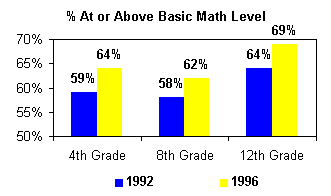
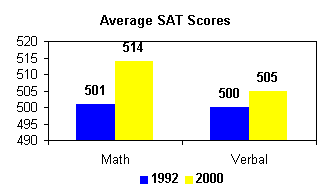
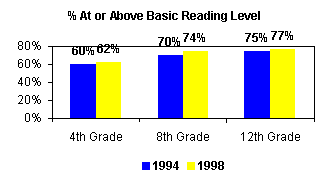
Scores on
the National Assessment of Educational Progress (NAEP), the Scholastic
Achievement Test (SAT), and the American College Test (ACT) and the number of
students taking Advanced Placement (AP) exams have all risen since 1992. This
year, math scores on the SAT have reached the highest average since 1969,
particularly notable because more students from different backgrounds are
taking the test. These gains are attributable at least in part to the fact that
more students are taking academically rigorous courses, including pre-calculus,
calculus and physics. The Clinton-Gore Administration’s emphasis on
standards and accountability has facilitated this change, as has the commitment
to expanding access to Advanced Placement courses and other rigorous curricula.
These achievement gains also reflect the impact that targeted, research-based
initiatives have had over the past seven-and-a-half years. Federal support for
such initiatives as class size reduction, comprehensive school reform, internet
access in classrooms, and after-school and other extended learning
opportunities have helped provide millions of students and their schools with
the tools they need to meet high standards. The President’s Fiscal Year
2001 budget seeks to continue and expand the federal commitment in several
areas crucial to continuing these academic achievement gains – including
$1.75 billion for Class Size Reduction, $1 billion for 21st Century
Community Learning Centers, $903 million for Education Technology, and $1
billion for improving teacher quality through a combination of recruitment,
retention, and professional development initiatives.
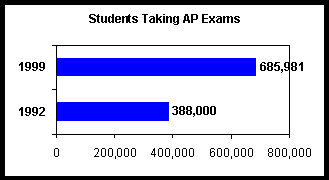
|
Then (1992 Unless otherwise indicated) |
Now (1999 Unless otherwise indicated) |
|
|
Graduating high schools seniors taking a core curriculum of 4 years of English and 3 years each of Math, Science and Social Studies |
38% (90) |
55% (98) |
|
Average class size in schools and grades participating in class size reduction initiative: |
23 (96) |
18 |
Closing the Achievement Gap: Ending the Era of Low Expectations
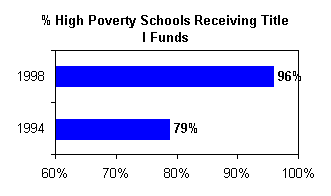
Low-Income Students: Today, nearly all of the
nation’s highest-poverty schools receive Title I funds, compared to fewer
than 80 percent at the start of the Administration, and the proportion of
low-income high school students advancing directly to college is on the rise.
New initiatives aimed at enhancing student learning and achievement, including
the 21st Century Community Learning Centers, Class Size Reduction,
and Educational Technology, have provided Title I schools and low-income
students with important tools for reaching high standards. Studies are also
confirming that achievement is negatively impacted when students attend schools
that have unhealthy and unsafe conditions, such as leaks and ventilation
problems. The Clinton-Gore Administration has been advocating the importance of
federal assistance through loans and zero-interest bonds to address the urgent
need for school construction and modernization across the country – in
fact, $127 billion is needed just to bring existing schools into acceptable
condition. This concerted attention to educational access and achievement
divides has helped to narrow test score gaps between high-poverty students and
their counterparts, though more needs to be done. In addition to increasing
funds for initiatives that help close the gap between disadvantaged students
and their peers such as Class Size Reduction, 21st Century Community
Learning Centers, the Technology Literacy Challenge Fund, Community Technology
Centers, and the Accountability Fund, the President’s FY 2001 budget
requests $50 million to recognize states that make significant statewide
progress in closing the achievement gap between groups of students.
|
Then (1992 Unless otherwise indicated) |
Now (1999 Unless otherwise indicated) |
|
|
Gap between reading performance of 9-year-olds in high-poverty schools and all 9-year-olds: |
29 points |
22 points (96) |
|
NAEP math performance of 9-year-olds in high-poverty schools: |
208 |
217 (96) |
|
Gap between math performance of 9-year-olds in high-poverty schools and all 9-year-olds: |
20 points |
13 points (96) |
|
Low-income high school graduates going directly to college: |
43.6 % |
50.6% (97) |
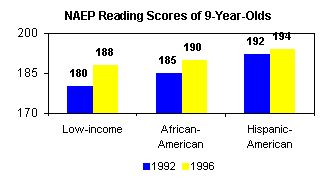
African-American Students: The reach of the
Clinton-Gore Administration’s focus on educational accountability and
elimination of the achievement gap has not been limited to just low-income
students. African American students as a group have also realized gains in test
scores, high school graduation rates, and the proportion of students continuing
directly on to college. The Administration’s credo of high expectations
and achievement for all – formally legislated in the Improving
America’s Schools Act of 1994 and coupled with targeted investment in what
works – has indeed made a difference. Beyond test score gains, more
African American students are taking a rigorous core curriculum and Advanced
Placement courses in high school than at the beginning of the Administration.
Continued cooperation from Congress and states on implementing accountability
provisions and in dedicating the necessary resources will be critical to making
further progress in the elimination of the achievement gap between school-aged
African Americans and their peers.
|
Then (1992 Unless otherwise indicated) |
Now (1999 Unless otherwise indicated) |
|
|
Reading test score gap between African American and White students (9 year olds): |
34 points |
30 points (96) |
|
Reading test score gap between African American and White students (17 year olds): |
37 points |
29 points (96) |
|
African American high school graduates going directly to college |
50% |
59% (98) |
|
African American SAT composite scores: |
849 (89) |
860 (2000) |
|
African Americans taking SAT exam: |
106,573 (96) |
119,394 |
|
African American students taking AP exams: |
10,448 (88) |
31,023 |
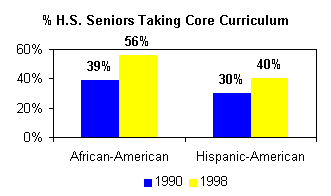
Hispanic-American Students: Over the course of the
Clinton-Gore Administration, the achievement gap between Hispanic and
non-Hispanic students has also narrowed. More Hispanic students are taking AP
courses and a core curriculum in high school than ever before, and the gap in
test scores on a variety of nationally-administered tests is narrowing as well.
A whole host of initiatives, including mentoring and college preparation
programs like GEAR UP and TRIO, as well as programs making up the comprehensive
Hispanic Education Action Plan (HEAP), which spans early childhood through
adult education, are likely contributing to these gains. However, progress for
Latino students is not happening quickly enough. Addressing the alarmingly low
rates of high school completion of Hispanic students, as well as the unique
needs of migrant and recently-immigrated, non-English speaking communities have
been top priorities of the Clinton-Gore Administration. In addition to creating
HEAP, the President’s recent Strategy Session on Improving Hispanic
Student Achievement which brought policymakers together with educators,
corporate interests and community leaders, complements other efforts being made
across federal agencies to further narrow the educational gaps between
Hispanics and their peers. The President’s FY 2001 budget proposes $823
million in increases for HEAP programs, including GEAR UP, Title I grants to
localities, Adult Education, Migrant Education, Bilingual Education, and
Hispanic Serving Institutions.
|
Then (1992 Unless otherwise indicated) |
Now (1999 Unless otherwise indicated) |
|
|
Hispanic Students Testing at or above Basic Math Level |
35% – 4th 34% – 8th 45% – 12th |
41% – 4th (96) 39% – 8th 50% – 12th |
|
25-29 year old Hispanic High School graduates with college degrees: |
15.6% |
16.5% (98) |
|
Hispanic students taking AP exams: |
13,322 (88) |
68,236 |
Advancing the Achievement of Students with Disabilities
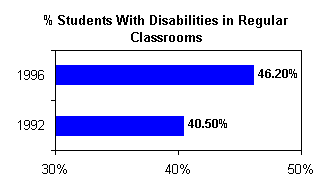
Greater attention to the needs of students with disabilities and early
intervention has enabled more special needs students to learn in regular
classrooms with their nondisabled peers, graduate from high school with a
regular diploma, and pursue postsecondary education. The Individuals with
Disabilities Act Amendments of 1997 made it clear that the education of
students with disabilities should be based on the same challenging standards as
applied to nondisabled students, with appropriate modifications and supports
for their disabilities. It also required students with disabilities to be
included in State and district-wide assessments, and that schools must also be
held accountable for the educational outcomes of students with disabilities.
The President’s FY 2001 budget further increases funds to states and
districts to provide the specialized educational assistance that students with
disabilities require, with an eye towards improving the learning and
achievement of all students. In addition, in recognizing the critical role that
qualified teachers play in the education of any child, the Administration has
also requested additional funds for special education professional development
and funds to help schools implement research-based practices and to assist
families provide crucial intervention services to children with
disabilities are early as possible.
|
Then (1992 Unless otherwise indicated) |
Now (1999 Unless otherwise indicated) |
|
|
Students with Disabilities graduating with diplomas: |
101,589 (92-93) |
134,319 (96-97) |
|
Students taking the SAT reporting a disabling condition: |
42,789 (96) 940 combined score |
73,169 (99) 949 combined score |
Greater Access to Quality Preschool Opportunities
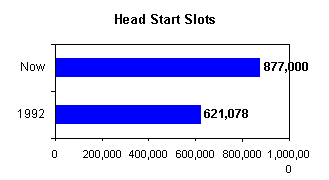
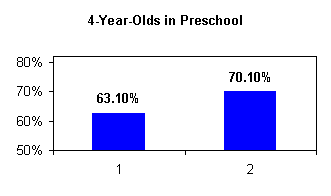
Scientific studies of brain and cognitive development have
made clear the long-term impact and importance of ensuring all families have
access to high quality early childhood education. The President and Vice
President have succeeded in expanding funding for the highly successful Head
Start program, which has been shown to improve vocabulary, math, and social
skills. These results persist over time. Head Start children have better high
school attendance rates, are less frequently retained in grade and have less
need for special education. In FY 1995, the Early Head Start program was
established in recognition of the importance of the earliest years, from birth
to three, in a child’s growth and development. The FY 2001 budget will
improve the quality of Early Head Start and add 10,000 children, raising
participation above 50,000. In the 1998 reauthorization of Head Start, the
Clinton-Gore Administration raised standards and increased accountability, and
also augmented the percentage of funds spent on ensuring quality in Head Start
centers. Today, not only does Head Start serve more children than ever, but
since 1993, 150 sub-par programs have been shut down while over 200 have
received intensive assistance to substantially improve the quality of their
programs. The Administration continues to make high-quality preschool
opportunities a high priority in the FY 2001 budget, establishing and funding
at $3 billion over five years their previously proposed Early Learning Fund for
grants to communities to foster cognitive development. The President and the
Vice President have also proposed $30 million for early childhood educator
professional development, as well as further increasing the number of Head
Start and Early Head Start slots to serve nearly 1 million children. The
Administration will continue to step up efforts to target groups that are
underrepresented in access to early childhood educational opportunities,
including recent immigrants and limited English proficient children. President
Clinton and Vice President Gore have also expanded the federal commitment in
the FY 2001 budget request for research on child development.
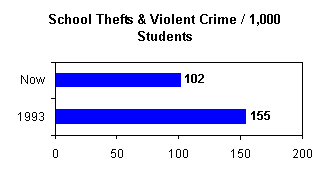
Increasing Children’s Safety and Improving
School Discipline
Though tragic, high-profile incidents have brought the
issue of school violence to the forefront recently, the good news is that
programs like the Safe and Drug Free Schools and Communities program and
policies such as the expanded adoption of smaller learning communities have
contributed to decreases in school crime and students bringing weapons to
school. School climate, sense of belonging, and adequate individual attention
are key factors in student behavior, and in his FY 2001 budget the President
promotes these strategies by increasing funds for Safe and Drug Free schools
and Communities to $650 million, increases Class Size
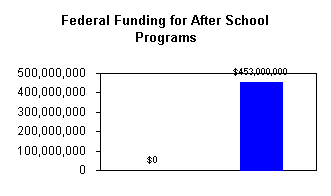
Reduction to $1.75
billion, and expanding the Small, Safe and Successful High Schools program from
$45 million to $120 million. Research shows that the hours after school lets
out is the time when most young people are likely to be victims of violent
crime, or use drugs and alcohol. Since it was started as a $1 million
demonstration program in 1997, President Clinton and Vice President Gore have
grown the 21st Century Community Learning Centers to a $453 million
program providing 850,000 children with after school and summer school
opportunities. Today, 3600 schools in over 900 communities are enriching the
lives of children through the 21st Century Community Learning
Centers, and the President’s FY 2001 request for $1 billion in funding for
the program would enable 2000 communities to provide expanded learning
opportunities in 8000 21st Century Community Learning Centers. In
addition, the Administration’s budget also requests nearly $250 million
for the Safe Schools / Healthy Students program to provide further assistance
to community-wide efforts to address mental health, juvenile justice and
education, and also calls on Congress to fund Project SERV (School Emergency
Response to Violence) as the next important steps in improving school safety
and discipline.
|
Then (1992 Unless otherwise indicated) |
Now (1999 Unless otherwise indicated) |
|
|
Public schools with mandatory uniform policies: |
1,700 (96) |
2,600 (97) |
|
Students bringing guns and other weapons to school: |
12% (93) |
9% (97) |
|
Children served by 21st Century Community Learning Centers: |
0 |
850,000 |
A Focus on Improving Teacher Quality
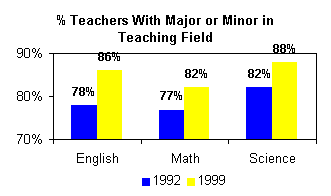
Research has shown that high-quality teachers are one of the
most important factors in student learning, and schools across the nation will
need to hire 2.2. million teachers over the next decade to meet the demand of
rising enrollments and replace a large pool of retiring Baby Boomers. The
Clinton-Gore Administration has made the recruitment, preparation, and training
of high-quality teachers a priority, by increasing professional development
grants and by raising the standards for teacher education and certification in
the Higher Education Act of 1998. Already there are tangible gains – more
teachers today have a major or minor in their primary teaching field than at
the beginning of the Administration, and innovations such as the
Troops-to-Teachers and the National Board for Professional Teaching Standards
have led more highly educated and well-trained individuals to come into and
stay in our classrooms. The Administration’s Elementary and Secondary
Education reauthorization proposal underscores the importance of every child
having a qualified teacher by requiring states to ensure that teachers are
fully qualified and certified, and expanding critical teacher recruitment,
preparation, and training mechanisms, including innovative methods to attract
mid-career professionals to the field. The President’s FY 2001 budget
provides $1 billion for a strengthened program of recruitment and training,
through expanding Troops-to-Teachers and other programs such as Hometown
Teachers, as well as expanded professional development in technology and early
childhood education, and incentive and reward programs for both districts and
teachers.
|
Then (1992 Unless otherwise indicated) |
Now (1999 Unless otherwise indicated) |
|
|
Teachers certified by the National Board of Professional Teaching Standards: |
282 (95) |
4,804 |
|
Troops to Teachers participants hired (cumulative): |
0 |
3,721 |
|
Eisenhower Professional Development Grants: |
$240 million |
$335 million |
Enhancing the Reach and Usage of Education Technology

The rising importance of technology and general computer
literacy has made closing the digital divide a national challenge, one which
has been a priority for the Clinton-Gore Administration. Whereas computers were
largely luxuries in the most affluent school districts just a decade ago, the
Administration’s aggressive E-Rate program has made it possible for nearly
all schools in the country, including even the poorest, to be connected to the
Internet and the wealth of resources associated with access to the digital
superhighway. Yet access alone is not sufficient, and the Administration has
led the crusade to work collaboratively with states, districts, industry
experts, and institutions of higher education – to make sure that adequate
pre-service and in-service professional development is available, so that
teachers can be comfortable integrating technology in their curricula, and to
ensure that appropriate software is developed – through the Preparing
Tomorrow’s Teachers to Use Technology and Technology Literacy Challenge
Fund programs. To ensure that technology provides schools and students with the
most effective applications to help them achieve and meet high standards, the
President’s FY 2001 budget calls for $450 million for the Technology
Literacy Challenge Fund and $170 million in funding for Next Generation
Technology Innovation grants, for state-of-the art educational technology,
including online and distance learning. The President’s budget also
includes increased commitments to Community Technology Centers and Preparing
Tomorrow’s Teachers to Use Technology programs.
|
Then (1992 Unless otherwise indicated) |
Now (1999 Unless otherwise indicated) |
|
Schools with internet access: |
35% (94) |
95% |
|
Community Technology Centers receiving Federal funds: |
0 |
170+ |
Increasing College Opportunity and Making College Affordable for All Americans
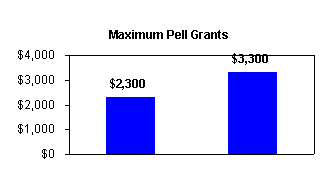
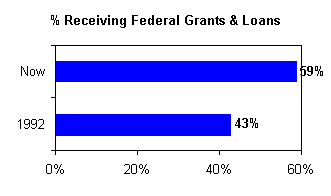
Education beyond high school is essential not only for
individual opportunity but for the health of the nation’s economy. The
Clinton-Gore Administration has been and continues to be extremely committed to
expanding access to post-secondary education, through tuition and loan
assistance and by implementing programs aimed at better preparing high school
students to continue their education after graduation from high school. Greater
numbers of high school graduates are going directly to college and more working
individuals are continuing their education today than ever before, thanks in
part to the largest federal investment in higher education since the G.I. Bill.
A nearly 50 percent increase in the maximum amount for federally-backed Pell
grants, a 40 percent increase in Work-Study assistance, and the new Hope
Scholarship and Lifetime Learning tax credits are now available to millions of
families continuing their education. More individuals are completing college
degrees and receiving federal aid today than just eight years ago, and whereas
more than 22 percent of student loan borrowers defaulted within two years of
entering repayment before the Clinton-Gore Administration, that rate has fallen
for seven straight years and is now a record-low 8.8 percent. At the same time,
collections on defaulted loans have tripled from $1 billion to $3
billion under this Administration. In addition, the AmeriCorps program has
provided education awards for over 150,000 young people to help them earn money
for college while serving their communities. In addition, the President and
Vice President have helped more low-income students prepare for college through
the Administration’s GEAR UP mentoring and college preparation initiative.
The President’s FY 2001 budget underscores the importance of increasing
access to higher education by providing an additional $125 million for GEAR UP;
an increase of $80 million for TRIO; funds to provide SAT and ACT preparation
courses for disadvantaged youth; and tax credits including the 10-year, $36
billion College Opportunity tax cut that will provide up to $2,800 in tax
relief for millions of families when fully implemented.
|
Then (1992 Unless otherwise indicated) |
Now (1999 Unless otherwise indicated) |
|
|
High school graduates going directly to college: |
62% |
66% (1998) |
|
GEAR UP participants: |
0 |
450,000 |
|
Work-study grant recipients: |
712,000 |
930,000 |
|
25-29 year olds with college degrees: |
27% |
32 % (98) |
|
Number of students benefiting from federal grants and loans: |
6,231,000 (43%) |
8,769,000 (59%) |
|
Students receiving AmeriCorps Education Awards to help pay for postsecondary education: |
0 |
150,000+ |
President and First Lady | Vice President and Mrs. Gore
Record of Progress | The Briefing Room
Gateway to Government | Contacting the White House | White House for Kids
White House History | White House Tours | Help
Privacy Statement